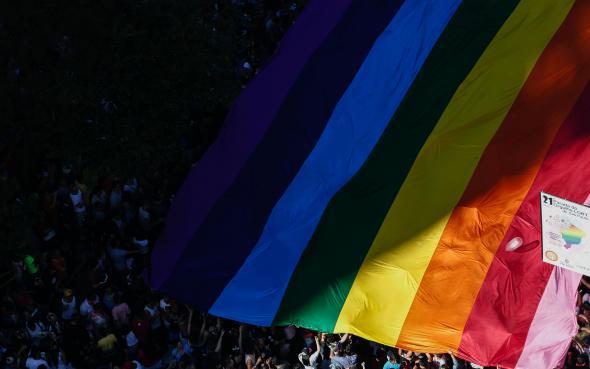Ask a room full of queers what Pride means—what the season is for—and you’re certain to get a few different answers. For some, it’s a time to commemorate the movement-energizing Stonewall rebellion of 1969 and to take stock of how far LGBTQ people have come on our road to legal and social equality in the 48 years since. Others, such as those staging protests at Pride parades around the country this summer, see it as an opportunity to take up the riotous spirit of our queer ancestors and demand better of our own leaders and our government, with a social justice platform that comprises far more than queer issues alone. And still others view it as a kind of carnival, a time to party with their queer siblings and revel in a season when we march down the main avenues of the culture rather than keeping to our typical sidelines.
At the heart of all these approaches to Pride is a single theme: visibility. Pride is our time to be seen. And with good reason: Since the earliest public homophile demonstrations—and growing exponentially with the ever-larger parades and rallies that proliferated following Stonewall—a single, elegant idea came to dominate thinking about queer liberation: LGBTQ people need to be seen to be respected. As the great gay politician and activist Harvey Milk put it: “My gay brothers and sisters … you must come out!”
Milk was thinking in broad political terms (if they know us, they won’t vote against us), but visibility is a prime concern for queer individuals as well. For example, I spend most of the year modulating my self-presentation depending on the spaces and people I encounter, never closeting myself entirely, but occasionally “toning it down” when I feel unsafe or just want to avoid drama. During Pride, however, I wear a rainbow bracelet 24/7—for the month of June, everyone will know who I am.
Of course, the fact that I might need to “tone it down” says something interesting about the queer relationship to visibility: We’re not just talking about the choice to wear rainbow jewelry. LGBTQ people, as a minority group whose difference isn’t necessarily always apparent, are obliged to negotiate when and how we want to be “clockable,” when we want to be seen by potential mates and friends and when we need to be hidden from those who hate us. Visibility is a double-edged sword we parry with every day.
An unscientific online survey Outward conducted bore this out. Respondents wrote happily about the ways in which they present themselves when they want to be visible: Gay and bi men turned most often to tighter, more tailored clothing; “skanky shirts”; colorful patterns; and freer “mannerisms.” Queer women, meanwhile, focused primarily on haircuts (“specifically like Rachel Maddow’s,” said one) and styling choices that danced across the gender binary.
Elle, a 29-year-old who identifies as “bisexual leaning heavily lesbian,” said: “I always wear my keys on a carabiner attached to my belt loop, which is strangely my most often recognized sign of potential lesbian interests. If I am trying to look specifically ‘queer,’ I guess I wear straight legged jeans, a cap with my ponytail through the loop, a T-shirt about snowmobiling, and boots.” Other people attributed queerness to certain articles of clothing, like the classic Doc Martens or specific tank tops: “either like tight with thin but not spaghetti straps or loose with wide straps.”
Choosing whether to rock the “thin but not spaghetti strap” look isn’t always just a matter of style, however. Though most respondents said they would always prefer to be visible, a number explained that they feel it necessary to cover their identities at work, with their biological family, or in uncertain spaces like public transit or a foreign country. At the same time, some mentioned that they felt more pressure to be visible under the current administration. Danny, who is 23, genderqueer, and gay, said that their recent experimentation with “feminine clothes and wearing makeup” was partly due to “the political climate, a response to anti-queer violence and just being tired of holding back.” And Ben, a 30-year-old gay male, said that due to fear of physical violence, he sometimes keeps his painted nails in his pockets; still, “more and more, it feels very political to be visible right now.”
The tying of visibility to political action should come as no surprise. In 2017, the status of visibility as a clear moral and strategic good feels self-evident; it’s a core component of the mainstream LGBTQ advocacy movement’s DNA and is largely credited with winning marriage equality. But is the situation so simple? Trans people are more visible than ever—and have been greeted by a harsh vigilante and state crackdown based in gender surveillance at bathroom doors. Queer folks are regularly pandered to by brands and represented on network TV, and yet our own traditional spaces, subcultures, and art forms are facing dilution and extinction. Conservatives are pushing “religious liberty” laws that respond to our now-undeniable existence by legalizing objections to our presence. Caitlyn Jenner, Peter Thiel, and a new generation of “homocons” are out there grabbing cameras and making history while much of their queer family looks on in despair.
Visibility, it seems, could use a re-examination, and we here at Outward think there’s no better time than Pride. So over the next week, we’ll be publishing a special package of articles looking at the issue from a range of angles, with contributions from writers living across the LGBTQ landscape. Our goal is not to encourage hiding—visibility has its place! Rather, we aim to complicate what visibility means for a people and a movement that, as it struggles to find a way forward after Obergefell and Trump, is finding it necessary to re-evaluate many of its long-standing values. We hope you’ll join us in that important conversation. Happy Pride!
